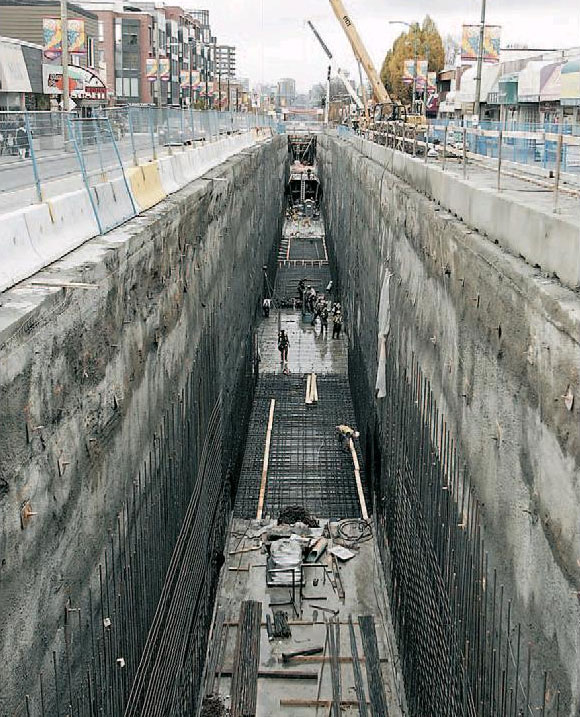Bob Ransford
Sun

The Canada Line – this image of constructon progress was shot this week – is not generating the densification along its Vancouver route that it could,Bob Ransford reports.
Public transit infrastructure should follow dense urban growth. Public transit infrastructure should be in place to attract more dense growth.
Density or urban infill growth and transit infrastructure need to be planned simultaneously and are dependent on each other.
Which of the foregoing three statements is correct when it comes to managing growth in a rapidly growing urban region?
Hopefully, common sense would tell you that we should plan density, or urban infill growth, at the same time we are planning the expansion of our integrated transit network in Metro Vancouver.
Unfortunately, there’s a shortage of common sense when it comes to our governing institutions and their decision-makers.
Mayor Sam Sullivan says that today, transit ridership in the Broadway corridor tops 60,000 people a day. He says this justifies the need to extend the Millennium SkyTrain system from Clark Drive all the way west to UBC.
I recall a similar argument being made when politicians were attempting to justify a $1-billion-plus expenditure on the Richmond-Airport-Vancouver rapid transit line a few years ago.
That project, now topping $2 billion as it approaches completion, runs through a continuous corridor of low-to medium-density development in Vancouver. There are a number of nodes south of the downtown peninsula where significant growth could occur along the Cambie Street-Canada Line corridor, but “could” is the operative word. Whether or not growth does occur along the Cambie corridor is up to Mayor Sullivan and Vancouver city council.
One small developer has been working for at least two years trying to get approval to build six fee-simple townhomes on a single-family lot that fronts directly on Cambie, not far from one of the Canada Line stations.
Not only will it be a model development for the kind of row-housing developments that don’t yet exist in this city, it is a form of modest density in an area that should welcome even more density.
Plans have been drafted for some modest new infill development around one of the more important Canada Line stations — Oakridge — at 41st Avenue. There are four other stations south of the density that will occur near the Olympic Village station on the southeast corner of False Creek. Density needs to occur around each of these stations, just as it is being planned around at least three of Richmond‘s four Canada Line stations.
We can’t afford to build a $2-billion transit system and have it serve an under-built corridor. The Canada Line was supposed to serve a corridor with existing density. It was also supposed to attract new density. Many would argue that the density it served was primarily commercial and institutional density, and not residential density. If the Oakridge plan is any indicator of the type of density increases we can expect to see around the other Canada Line stations, the whole project has failed.
There are already two transit corridors that run east-west through the eastern part of the city where growth has yet to live up to the potential that rapid transit was meant to spur. One line has been in place for more than two decades.
The other, about a decade. There are at least five transit stations along these two lines where the predominant form of residential development within walking distance of the station is still single-family residential.
What is an appropriate density along these transit lines and around their stations? Look at how Burnaby has planned growth around most of the 11 stations in that municipality. Infill development around the Patterson, Metrotown and Edmonds stations has now matured and is a good example of the kind of medium- to high-density development that should be developed around transit stations.
Similar growth is underway around at least three or four other SkyTrain stations in Burnaby.
the potential for infill growth around its SkyTrain stations. That city has the potential of developing an entire new downtown around the Surrey Central station.
It seems as though decision-makers and developers in Surrey are beginning to realize that potential.
That leaves Vancouver. Before the mayor talks a lot more about extending the rapid transit system along Broadway, perhaps he can demonstrate what the city is prepared to accommodate in terms of new growth around Vancouver‘s existing SkyTrain stations.
– – –
Bob Ransford is a public affairs consultant with CounterPoint Communications Inc. He is a former real estate developer who specializes in urban land use issues. E-mail: [email protected]
© The Vancouver Sun 2007
